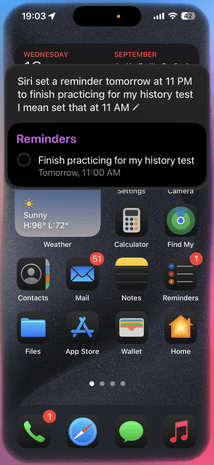Siri facts for kids

The Apple Intelligence Siri logo in iOS 18 and macOS Sequoia
|
|

Apple Intelligence-based Siri running on iOS 18
|
|
| Original author(s) | Siri Inc. |
|---|---|
| Developer(s) | Apple |
| Initial release | October 4, 2011 |
| Operating system | iOS 5 onward, macOS Sierra onward, tvOS (all versions), watchOS (all versions), iPadOS (all versions), visionOS (all versions) |
| Platform |
|
| Available in | |
| Type | Intelligent personal assistant |
Siri is a digital assistant from Apple Inc. that is part of its operating systems, like iOS and macOS. You can find Siri on the iPhone, iPad, Apple Watch, and other Apple devices.
Siri uses voice commands and a natural-language user interface (which means it understands how people normally talk). You can ask it questions, get recommendations, and tell it to do things on your device. Siri learns from how you use it to give you better, more personal results over time.
Siri started as a project from the SRI International Artificial Intelligence Center. Apple bought the company in 2010 and built it into the iPhone 4S in 2011. Since then, Siri has become a key feature of Apple's products.
Contents
How Siri Was Made
Siri was created by a company that spun off from a research project funded by the U.S. government. The name "Siri" was chosen by one of its co-founders, Dag Kittlaus. It's a Norwegian name that means "beautiful victory."
Apple bought Siri in April 2010. The idea for a digital assistant like Siri was something Apple had thought about for a long time. They even made a concept video about it way back in 1987 called Knowledge Navigator.
Where Siri's Voices Came From
The original voices for Siri were recorded around 2005. The voice actors didn't even know their recordings would be used for a famous digital assistant!
- American Voice: The original American female voice was recorded by Susan Bennett.
- British Voice: The original British male voice was provided by Jon Briggs, who was a journalist and narrator for a TV game show.
- Australian Voice: The original Australian female voice belongs to Karen Jacobsen, a voice-over artist.
In 2017, for iOS 11, Apple recorded new voices using deep learning technology to make them sound more natural. In 2022, Apple also added a gender-neutral voice option.
How Siri Works
Siri was first released as a separate app in February 2010. After Apple bought it, Siri was built directly into the iPhone 4S. Over the years, Apple has added Siri to many more devices.

You can now use Siri on:
- iPhone, iPad, and iPod Touch
- Mac computers
- Apple TV
- Apple Watch
- HomePod and HomePod Mini
- AirPods
- Apple Vision Pro
What Can You Ask Siri?
Siri can do many things when you ask. Here are some examples:
- Phone and Messages: "Call Mom," "Read my new messages," or "Set a timer for 10 minutes."
- Basic Information: "What's the weather like?" or "How many people live in France?" Siri often uses Wikipedia for facts.
- Scheduling: "Schedule a meeting for 3 PM" or "Remind me to do my homework."
- Device Settings: "Take a picture," "Turn off Wi-Fi," or "Make the screen brighter."
- Internet Search: "Find pictures of golden retrievers" or "Search the web for fun science experiments."
- Navigation: "Take me home" or "What's traffic like?"
- Translation: "How do you say 'hello' in Spanish?"
- Entertainment: "What movies are playing near me?" or "Play my workout playlist."
Siri is also known for its funny answers to silly questions. If you ask, "Hey Siri, knock knock," it will tell you a joke.
How to Talk to Siri
At first, you had to press a button to talk to Siri. In 2014, Apple added the "Hey Siri" command, so you could activate it just by speaking.
With iOS 17, you can now just say "Siri" to get its attention. You can also ask several questions in a row without having to say "Siri" each time.
Siri Gets Smarter with Apple Intelligence
Siri has been upgraded with Apple Intelligence, which is Apple's own brand of artificial intelligence. In iOS 18, iPadOS 18, and macOS Sequoia, Siri has a new look and understands language better. You can also type to Siri by double-tapping the home bar on an iPhone or iPad.
With Apple Intelligence, Siri can understand the context of what you're doing on your device. For example, if you ask, "When is Mom's flight landing?" Siri can find the flight information in your messages or email and give you a real-time update. It can also summarize long messages and emails for you.
Challenges and Improvements
When Siri first came out, people had mixed feelings. They liked that it could understand voices and use information from their calendars. But some people found it wasn't very flexible and didn't always understand different accents.
Around 2016 and 2017, some reports said Siri was falling behind competitors like Amazon's Alexa and Google Assistant. Critics felt that Siri wasn't getting new features fast enough. Some people believed this was because Apple focused heavily on user privacy, which made it harder for Siri to learn from user data compared to its competitors.
Apple has worked to improve Siri by making it faster and more reliable. The company says it can improve Siri while still protecting user privacy by doing a lot of the learning on the device itself, instead of in the cloud.
Siri for Everyone
Apple has added features to make Siri helpful for people with disabilities.
- VoiceOver: This feature reads Siri's responses out loud and shows them on the screen.
- Type to Siri: Users who are unable to speak can type their commands to Siri.
- Personal Voice: This feature lets users create a digital voice that sounds just like them. This is very helpful for people who might lose their ability to speak.
- Atypical Speech Recognition: Siri is being trained to better understand people with speech patterns that are different from the average user.
Bias in AI
Like many AI systems, Siri has faced criticism about bias. For a long time, Siri's default voice was female, which some people felt reinforced stereotypes about women being assistants. Apple has since added more voice options, including male and gender-neutral voices, and in some countries, the default is no longer female.
Another challenge is that voice assistants sometimes have trouble understanding non-native English speakers or different accents. As AI learns from more and more people, the goal is for it to better understand everyone, no matter how they speak.
See also
 In Spanish: Siri para niños
In Spanish: Siri para niños
- List of speech recognition software
- Amazon Alexa

